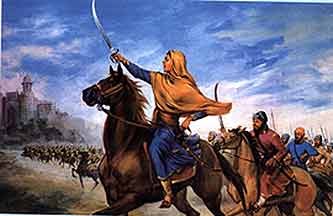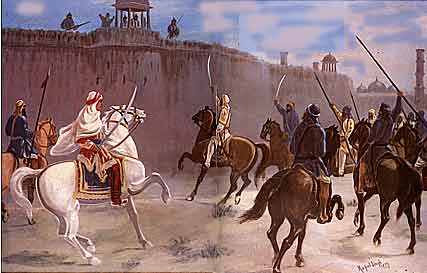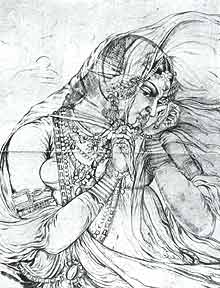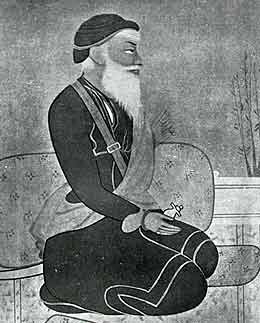
Sada Kaur was born in 1762. From her early childhood she showed clear signs of being endowed with her warlike forefathers' spirit and leadership qualities. She mastered the soldierly art of horse riding and wielding weapons of war. Sada Kaur married Gurbaksh Singh Kanhaiya, the only son of the powerful Misaldar, Jai Singh Kanhaiya.
Charat Singh Sukarchakia's son, Mahan Singh, succeeded in raising his misal to an important confederacy. This aroused the envy of the most powerful misal, the Kanhaiyas. The two came into conflict over the control of Jammu, and in one of the many battles that took place between them, Gurbaksh Singh was killed. Jai Singh's pride was humbled and he agreed to the betrothal of his deceased son's only child, Mehtab Kaur, to Mahan Singh's five-year-old son, Ranjit Singh. Jai Singh died shortly afterwards, leaving the Kanhaiya misal to his widowed daughter-in-law, Sada Kaur, the mother of Mehtab Kaur. Mahan Singh Sukarchakia died in 1792. The legacy, which Ranjit Singh inherited from his father, consisted of a large district in the heart of the Panjab. Ranjit Singh married Mehtab Kaur in 1796.

When Ranjit Singh received an invitation from the important citizens of Lahore to fin-ish Bhangi's misrule and take over their city, he sought Sada Kaur's advice. She told Ranjit Singh that whosoever controls the capital of the state will soon become the master of the Panjab. She, however, ad-vised him to tell his soldiers and command-ers not to plunder or inflict suffering on the innocent citizens. They should be told that they were going to Lahore not as con-querors but as friends and deliverers. On June 26,1799, with an army of 25,000 se-lect soldiers, Ranjit Singh marched towards Lahore and reached there in the evening. By sunrise, Ranjit Singh's forces were ready for attack. Special troops entered through the breaches made in the walls. They asked the citizens of Lahore to open the gates for Ranjit Singh's troops to enter. Ranjit Singh entered the city through Lahori Gate and Sada Kaur led her horsemen through Delhi Gate. Lahore was taken with little blood-shed or loss of life.
For providing effective guidance and support to Ranjit Singh in his early con-quests, Sada Kaur has been rightly called 'the ladder by which Ranjit Singh climbed to his glories as Maharaja of the Panjab'.
(Article- courtesy Dr. Santokh Singh -"The Guru's Word")

